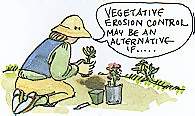 Certain
Certain
parts of the Puget Sound shoreline are subject to high rates of
erosion. Areas with high banks, areas adjacent to open water,
and areas subject to prevailing winds can erode over 10 feet in
a single year. Such areas are often important feeders of sediment
for our beaches. We can inadvertently accelerate this erosion
by clearing shorefront areas, altering marshes, building close
to the shoreline, and by boating.
Shoreline
and streambank erosion control share many of the same techniques.
Structural solutions to shoreline erosion control, such as rock
bulkheads, can be expensive, work with varying success, and can
cause erosion along other parts of the shoreline. Vegetative planting
is less expensive and, in many situations, can be just as effective
as structural solutions. Vegetation cannot provide protection
in severe exposure and requires more maintenance and protection
from human disturbance. In your planning, again recognize that
erosion is a natural process with some real benefits. Your goal
should be to stop excessive erosion.


